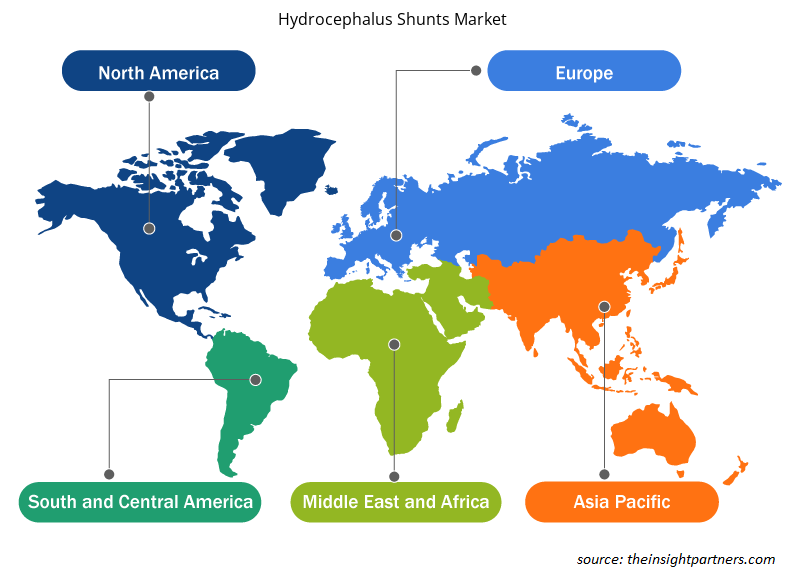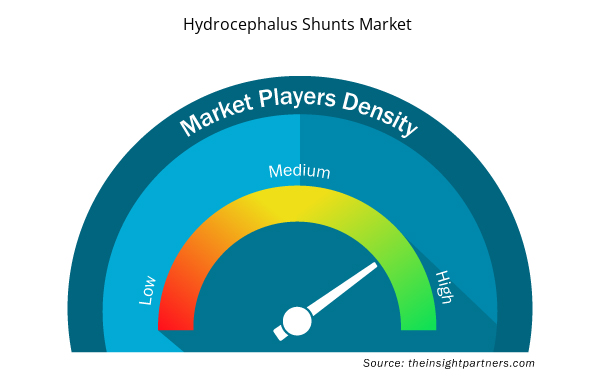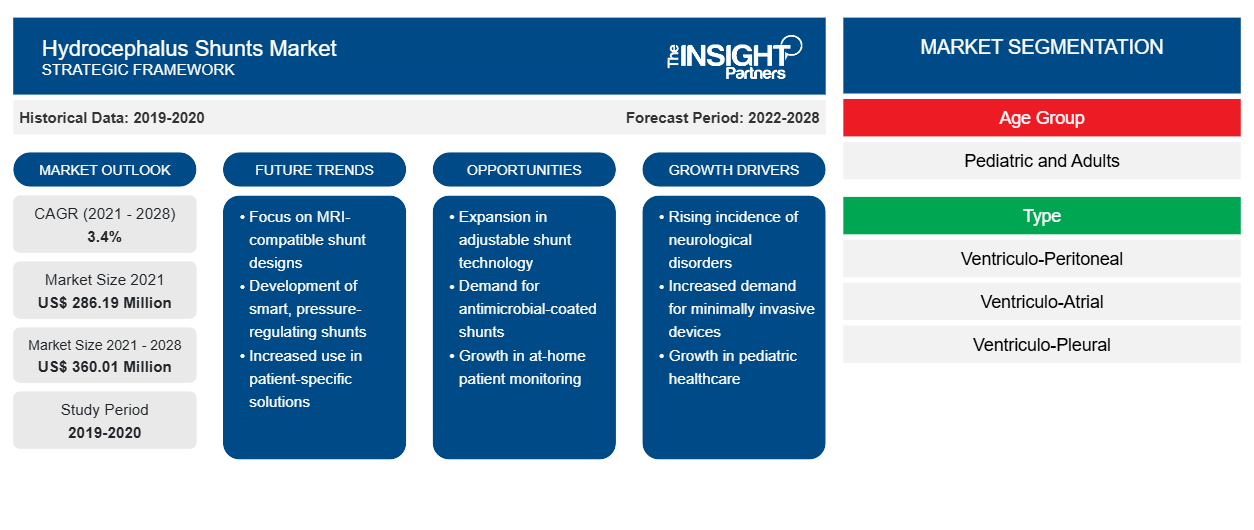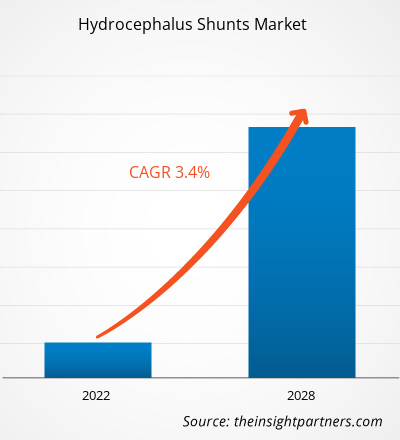Se espera que el mercado de derivaciones para hidrocefalia crezca US$ 360,01 millones para 2028; se estima que crecerá a una CAGR del 3,4% entre 2022 y 2028. CAGR of 3.4% from 2022 to 2028.
La hidrocefalia es una acumulación de líquido en el cerebro que ejerce presión sobre él. Es común en adultos mayores y bebés. Entre los síntomas que experimentan los pacientes con hidrocefalia se encuentran dolor de cabeza, problemas de visión, dificultades cognitivas, pérdida de la capacidad de coordinación e incontinencia. Puede causar agrandamiento de la cabeza en los bebés. Una derivación para hidrocefalia es la inserción quirúrgica de un sistema de drenaje que ayuda a drenar el exceso de líquido del cerebro.
Personalice este informe según sus necesidades
Obtendrá personalización en cualquier informe, sin cargo, incluidas partes de este informe o análisis a nivel de país, paquete de datos de Excel, así como también grandes ofertas y descuentos para empresas emergentes y universidades.
- Obtenga las principales tendencias clave del mercado de este informe.Esta muestra GRATUITA incluirá análisis de datos, desde tendencias del mercado hasta estimaciones y pronósticos.
El mercado de las derivaciones para hidrocefalia está segmentado en función del grupo de edad, el tipo, el producto, el usuario final y la geografía. Por geografía, el mercado está ampliamente segmentado en América del Norte, Europa, Asia Pacífico, Oriente Medio y África, y América del Sur y Central. Este informe ofrece información y un análisis profundo del mercado con énfasis en parámetros como las tendencias y la dinámica del mercado. También destaca el análisis competitivo de los principales actores a nivel mundial en el mercado de las derivaciones para hidrocefalia.
Perspectivas del mercado
La creciente prevalencia de la hidrocefalia impulsa el mercado de las derivaciones para hidrocefalia
La hidrocefalia es más frecuente en niños y bebés que en la población adulta en todo el mundo. Además, la enfermedad también es frecuente en personas de 60 años o más. Según la Asociación de Hidrocefalia, la enfermedad afecta a más de un millón de estadounidenses. Además, la tasa de incidencia de la hidrocefalia en los EE. UU. es de 1 de cada 770 bebés.
Según el artículo “Global hydrocephalus epidemiology and incidence: systematic review and meta-analysis”, publicado en el Journal of Neurosurgery (JNS) en 2019, los países de ingresos bajos y medios, en particular los de África y América Latina, son los que sufren la mayor carga de hidrocefalia. El artículo también afirma que el África subsahariana registró una incidencia anual de más de 225.000 nuevos casos de hidrocefalia infantil, es decir, 750 nuevos casos por cada 100.000 nacidos vivos. Además, en una cohorte europea, la tasa de incidencia se estimó en 110 casos de hidrocefalia infantil por cada 100.000 nacidos vivos.JNS) in 2019, low-income and middle-income countries, particularly those in Africa and Latin America, incur the most significant burden of hydrocephalus. The article also states that Sub-Saharan Africa witnessed an annual incidence of more than 225,000 new cases of infant hydrocephalus, i.e., 750 new cases per 100,000 live births. Moreover, in a European cohort, the incidence rate was estimated at 110 cases of infantile hydrocephalus per 100,000 live births.
El enfoque del tratamiento de la hidrocefalia se centra en gran medida en el manejo del LCR a través de dispositivos médicos llamados derivaciones. Los sistemas de derivación extraen el exceso de líquido cefalorraquídeo del cerebro y lo desvían a otras partes del cuerpo, donde se absorbe como parte del proceso circulatorio. Por lo tanto, la alta incidencia de derivaciones de hidrocefalia impulsa la demanda de derivaciones de hidrocefalia, lo que impulsa el crecimiento del mercado de la hidrocefalia.CSF through medical devices named shunts. The shunt systems remove excess cerebrospinal fluid from the brain and divert it to other body parts, wherein it is absorbed as a part of the circulatory process. Thus, the high incidence of hydrocephalus leads drives the demand for hydrocephalus shunts, thereby boosting the hydrocephalus market growth
Información sobre el producto
Según el producto, el mercado de derivaciones para hidrocefalia se segmenta en válvulas para hidrocefalia, catéteres para hidrocefalia, sistemas de neuronavegación systems y otros. El segmento de válvulas para hidrocefalia tuvo la mayor participación de mercado en 2021 y también se prevé que registre la CAGR más alta del 3,6 % durante el período de pronóstico. El mercado de válvulas para hidrocefalia se divide además en válvulas de presión ajustables y válvulas de presión fija. CAGR of 3.6% during the forecast period. The market for hydrocephalus valves is further bifurcated into adjustable pressure valves and fix pressure valves.
Tipo de información
Según el tipo, el mercado de derivaciones para hidrocefalia se segmenta en ventrículo-peritoneal, ventriculoatrial, ventrículo-pleural y lumbo-peritoneal. En 2021, el segmento ventrículo-peritoneal tuvo la mayor participación del mercado. Además, se espera que el mercado de este segmento crezca a una CAGR significativa del 3,7% durante el período de pronóstico.
Perspectivas sobre grupos de edad
Según el grupo de edad, el mercado de derivaciones para hidrocefalia se segmenta en pediátricos y adultos. En 2021, el segmento pediátrico tuvo una mayor participación en el mercado. Además, se estima que registrará una CAGR significativa del 3,5 % durante el período de pronóstico.
Perspectivas regionales del mercado de derivaciones para hidrocefalia
Los analistas de Insight Partners explicaron en detalle las tendencias y los factores regionales que influyen en el mercado de derivaciones para hidrocefalia durante el período de pronóstico. Esta sección también analiza los segmentos y la geografía del mercado de derivaciones para hidrocefalia en América del Norte, Europa, Asia Pacífico, Oriente Medio y África, y América del Sur y Central.

- Obtenga datos regionales específicos para el mercado de derivaciones de hidrocefalia
Alcance del informe de mercado de derivaciones para hidrocefalia
| Atributo del informe | Detalles |
|---|---|
| Tamaño del mercado en 2021 | US$ 286,19 millones |
| Tamaño del mercado en 2028 | US$ 360,01 millones |
| CAGR global (2021-2028) | 3,4% |
| Datos históricos | 2019-2020 |
| Período de pronóstico | 2022-2028 |
| Segmentos cubiertos | Por grupo de edad
|
| Regiones y países cubiertos | América del norte
|
| Líderes del mercado y perfiles de empresas clave |
|
Densidad de actores del mercado de derivaciones para hidrocefalia: comprensión de su impacto en la dinámica empresarial
El mercado de las derivaciones para hidrocefalia está creciendo rápidamente, impulsado por la creciente demanda de los usuarios finales debido a factores como la evolución de las preferencias de los consumidores, los avances tecnológicos y una mayor conciencia de los beneficios del producto. A medida que aumenta la demanda, las empresas amplían sus ofertas, innovan para satisfacer las necesidades de los consumidores y aprovechan las tendencias emergentes, lo que impulsa aún más el crecimiento del mercado.
La densidad de actores del mercado se refiere a la distribución de las empresas o firmas que operan dentro de un mercado o industria en particular. Indica cuántos competidores (actores del mercado) están presentes en un espacio de mercado determinado en relación con su tamaño o valor total de mercado.
Las principales empresas que operan en el mercado de derivaciones para hidrocefalia son:
- B. Braun Melsungen AG (CHRISTOPH MIETHKE GMBH & CO. KG)
- Sofisa
- Prótesis HpBio, inc.
- Corporación Integra LifeSciences Holdings
- CORP. KANEKA MEDIX CORP.
Descargo de responsabilidad : Las empresas enumeradas anteriormente no están clasificadas en ningún orden particular.

- Obtenga una descripción general de los principales actores clave del mercado de derivaciones para hidrocefalia
Información para el usuario final
Según el usuario final, el mercado de derivaciones para hidrocefalia se segmenta en hospitales, centros quirúrgicos ambulatorios y otros. El segmento hospitalario tuvo la mayor participación de mercado en 2021 y se espera que registre la CAGR más alta del 3,8 % durante el período de pronóstico.
Las estrategias orgánicas, como los lanzamientos y las aprobaciones de productos, son estrategias de crecimiento muy adoptadas por las empresas del mercado de las derivaciones para hidrocefalia. A continuación, se enumeran algunos de los desarrollos clave recientes del mercado.
- En mayo de 2020, Aesculap, Inc., en asociación con The Christoph Miethke GmbH & Co. KG (MIETHKE), anunció el lanzamiento de la válvula M.blue en EE. UU. La válvula M.blue cuenta con tecnología gravitacional avanzada, que se incorpora con una unidad de presión diferencial fija en una válvula. Ayuda a proporcionar una solución simple y dependiente de la posición.
- En julio de 2019, Integra LifeSciences anunció la adquisición de Arkis Biosciences Inc., una empresa privada que ofrece una cartera de dispositivos neuroquirúrgicos, como catéteres. La adquisición de Arkis Biosciences fortaleció la oferta de Integra en cuidados neurocríticos y la posición de Integra como líder mundial en tecnología avanzada de catéteres.
Perfiles de empresas
- B. Braun Melsungen AG (CHRISTOPH MIETHKE GMBH & CO. KG)
- Sofisa
- Prótesis HpBio, inc.
- Corporación Integra LifeSciences Holdings
- CORP. KANEKA MEDIX CORP.
- Medtronic S.A.
- Natus Medical Incorporated
- Spiegelberg GmbH & Co. KG
- Desu Medical
- Análisis histórico (2 años), año base, pronóstico (7 años) con CAGR
- Análisis PEST y FODA
- Tamaño del mercado Valor/volumen: global, regional, nacional
- Industria y panorama competitivo
- Conjunto de datos de Excel



Report Coverage
Revenue forecast, Company Analysis, Industry landscape, Growth factors, and Trends

Segment Covered
This text is related
to segments covered.

Regional Scope
North America, Europe, Asia Pacific, Middle East & Africa, South & Central America

Country Scope
This text is related
to country scope.
Preguntas frecuentes
Global hydrocephalus shunts market is segmented by region into North America, Europe, Asia Pacific, Middle East & Africa and South & Central America. The North America region held the largest market for the hydrocephalus shunts market during the forecast period. The large share of North America in the global hydrocephalus shunts market is attributed to factors such as the growing usage of innovative technologies that offer faster discovery and product development. Moreover, wide-ranging R&D activities by numerous organizations support new product launches in the region ultimately driving the overall hydrocephalus shunts market during the forecast period.
Thermo Fisher Scientific and Agilent Technologies, Inc. are the top two companies that hold huge market shares in the Hydrocephalus Shunts market.
The hydrocephalus shunts market majorly consists of the players such as B. Braun Melsungen AG (CHRISTOPH MIETHKE GMBH & CO. KG); Sophysa; HpBio Próteses, inc.; Integra LifeSciences Holdings Corporation; KANEKA MEDIX CORP.; Medtronic; Natus Medical Incorporated; Spiegelberg GmbH & Co. KG, and Desu Medical. among others.
The hospitals segment dominated the global hydrocephalus shunts market and held the largest market share of 54.99% in 2021.
The pediatric segment dominated the global hydrocephalus shunts market and held the largest market share of 57.17% in 2021.
The ventriculo-peritoneal segment dominated the global hydrocephalus shunts market and accounted for the largest market share of 44.44% in 2021.
The hydrocephalus valves segment held the largest share of the market in the global hydrocephalus shunts market and held the largest market share of 61.85% in 2021.
Shunt, the surgical insertion of a drainage system is the most common remedy for hydrocephalus. It drains extra cerebrospinal fluid from the brain to another part of the body such as the abdomen, where it can be more easily absorbed. It consists of a long and flexible tube with a valve that keeps fluid from the brain flowing in the right approach and at the proper rate.
Key factors that are driving the growth of this market are the increasing prevalence of hydrocephalus and increasing advancement in hydrocephalus valves.
The CAGR value of the Hydrocephalus Shunts market during the forecasted period of 2022-2028 is 3.4%.
Trends and growth analysis reports related to Life Sciences : READ MORE..
The List of Companies - Hydrocephalus Shunts Market
- B. Braun Melsungen AG (CHRISTOPH MIETHKE GMBH & CO. KG)
- Sophysa
- HpBio Próteses, inc.
- Integra LifeSciences Holdings Corporation
- KANEKA MEDIX CORP.
- Medtronic
- Natus Medical Incorporated
- Spiegelberg GmbH & Co. KG
- Desu Medical
The Insight Partners performs research in 4 major stages: Data Collection & Secondary Research, Primary Research, Data Analysis and Data Triangulation & Final Review.
- Data Collection and Secondary Research:
As a market research and consulting firm operating from a decade, we have published and advised several client across the globe. First step for any study will start with an assessment of currently available data and insights from existing reports. Further, historical and current market information is collected from Investor Presentations, Annual Reports, SEC Filings, etc., and other information related to company’s performance and market positioning are gathered from Paid Databases (Factiva, Hoovers, and Reuters) and various other publications available in public domain.
Several associations trade associates, technical forums, institutes, societies and organization are accessed to gain technical as well as market related insights through their publications such as research papers, blogs and press releases related to the studies are referred to get cues about the market. Further, white papers, journals, magazines, and other news articles published in last 3 years are scrutinized and analyzed to understand the current market trends.
- Primary Research:
The primarily interview analysis comprise of data obtained from industry participants interview and answers to survey questions gathered by in-house primary team.
For primary research, interviews are conducted with industry experts/CEOs/Marketing Managers/VPs/Subject Matter Experts from both demand and supply side to get a 360-degree view of the market. The primary team conducts several interviews based on the complexity of the markets to understand the various market trends and dynamics which makes research more credible and precise.
A typical research interview fulfils the following functions:
- Provides first-hand information on the market size, market trends, growth trends, competitive landscape, and outlook
- Validates and strengthens in-house secondary research findings
- Develops the analysis team’s expertise and market understanding
Primary research involves email interactions and telephone interviews for each market, category, segment, and sub-segment across geographies. The participants who typically take part in such a process include, but are not limited to:
- Industry participants: VPs, business development managers, market intelligence managers and national sales managers
- Outside experts: Valuation experts, research analysts and key opinion leaders specializing in the electronics and semiconductor industry.
Below is the breakup of our primary respondents by company, designation, and region:

Once we receive the confirmation from primary research sources or primary respondents, we finalize the base year market estimation and forecast the data as per the macroeconomic and microeconomic factors assessed during data collection.
- Data Analysis:
Once data is validated through both secondary as well as primary respondents, we finalize the market estimations by hypothesis formulation and factor analysis at regional and country level.
- Macro-Economic Factor Analysis:
We analyse macroeconomic indicators such the gross domestic product (GDP), increase in the demand for goods and services across industries, technological advancement, regional economic growth, governmental policies, the influence of COVID-19, PEST analysis, and other aspects. This analysis aids in setting benchmarks for various nations/regions and approximating market splits. Additionally, the general trend of the aforementioned components aid in determining the market's development possibilities.
- Country Level Data:
Various factors that are especially aligned to the country are taken into account to determine the market size for a certain area and country, including the presence of vendors, such as headquarters and offices, the country's GDP, demand patterns, and industry growth. To comprehend the market dynamics for the nation, a number of growth variables, inhibitors, application areas, and current market trends are researched. The aforementioned elements aid in determining the country's overall market's growth potential.
- Company Profile:
The “Table of Contents” is formulated by listing and analyzing more than 25 - 30 companies operating in the market ecosystem across geographies. However, we profile only 10 companies as a standard practice in our syndicate reports. These 10 companies comprise leading, emerging, and regional players. Nonetheless, our analysis is not restricted to the 10 listed companies, we also analyze other companies present in the market to develop a holistic view and understand the prevailing trends. The “Company Profiles” section in the report covers key facts, business description, products & services, financial information, SWOT analysis, and key developments. The financial information presented is extracted from the annual reports and official documents of the publicly listed companies. Upon collecting the information for the sections of respective companies, we verify them via various primary sources and then compile the data in respective company profiles. The company level information helps us in deriving the base number as well as in forecasting the market size.
- Developing Base Number:
Aggregation of sales statistics (2020-2022) and macro-economic factor, and other secondary and primary research insights are utilized to arrive at base number and related market shares for 2022. The data gaps are identified in this step and relevant market data is analyzed, collected from paid primary interviews or databases. On finalizing the base year market size, forecasts are developed on the basis of macro-economic, industry and market growth factors and company level analysis.
- Data Triangulation and Final Review:
The market findings and base year market size calculations are validated from supply as well as demand side. Demand side validations are based on macro-economic factor analysis and benchmarks for respective regions and countries. In case of supply side validations, revenues of major companies are estimated (in case not available) based on industry benchmark, approximate number of employees, product portfolio, and primary interviews revenues are gathered. Further revenue from target product/service segment is assessed to avoid overshooting of market statistics. In case of heavy deviations between supply and demand side values, all thes steps are repeated to achieve synchronization.
We follow an iterative model, wherein we share our research findings with Subject Matter Experts (SME’s) and Key Opinion Leaders (KOLs) until consensus view of the market is not formulated – this model negates any drastic deviation in the opinions of experts. Only validated and universally acceptable research findings are quoted in our reports.
We have important check points that we use to validate our research findings – which we call – data triangulation, where we validate the information, we generate from secondary sources with primary interviews and then we re-validate with our internal data bases and Subject matter experts. This comprehensive model enables us to deliver high quality, reliable data in shortest possible time.


 Obtenga una muestra gratuita de este informe
Obtenga una muestra gratuita de este informe